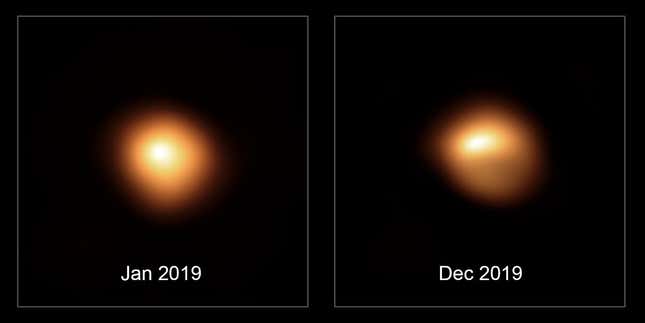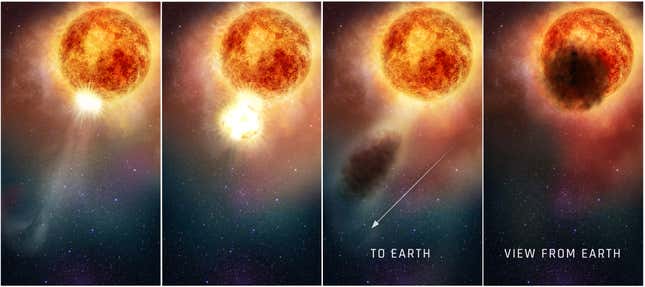The expiration date of Betelgeuse, an enormous dying star about 642 light-years from Earth, is a sizzling matter in astronomy due to the star’s superlative measurement and its life cycle stage.
Betelgeuse is between 10 and 20 occasions the mass of our Solar, with a radius about 900 occasions higher. It’s burning rapidly, and shortly (in cosmic phrases) will die.
When stars die, they expel most of their materials out into the cosmos in a outstanding explosion known as a supernova. If the circumstances are proper, the supernova leaves a serene stellar nebula in its wake.
Our own Sun will go through this process in about 5 billion years, however Betelgeuse is far, a lot nearer to its endgame. And whereas stars within the distant universe go supernova all the time, Betelgeuse is in our personal galaxy, principally on our doorstep in cosmic phrases.
Earlier this month, a group of researchers posted a paper to the preprint server arXiv. Within the paper, the group posited that Betelgeuse is already in “the late stage of core carbon burning,” and thus was a strong candidate for our galaxy’s most imminent supernova. “In response to this determine, the core will collapse in a couple of tens years after the carbon exhaustion,” the researchers wrote.
On social media, some took this to imply the supernova would happen within the subsequent century, and even within the subsequent few many years. However carbon burning is a gradual course of, even when Betelgeuse—which we’re allowed to write down as many occasions as we wish with out supernatural repercussions—is at that time.
In an e-mail to Gizmodo, Hideyuki Saio, an astronomer at Tohoku College and the preprint’s lead writer, advised Gizmodo that the group predicts the supernova will occur in “lower than a couple of hundred years.”
To an extent, the thrill round Saio’s revised timeline is a sufferer of individuals not intently studying the conclusion of his group’s paper. Besides, scientists unaffiliated with the analysis say that the group’s mannequin doesn’t clarify the star’s scenario.
“It’s not possible for us to see what’s happening inside even our personal Solar, not to mention a star that’s tons of of light-years away,” mentioned Emily Hunt, an astronomer on the Universität Heidelberg who was not affiliated with the latest paper, in a cellphone name to Gizmodo. “Simply because the mannequin explains the observations, it doesn’t imply that the mannequin is appropriate.”
“It’s actually dangerous that we’ve seen so many individuals take up this one paper and take it as gospel, when truly it’s only one interpretation of the observations,” Hunt added.
Betelgeuse is sort of younger—about 10 million years old—however will burn out rather more rapidly than the Solar. Over the course of its evolution, Betelgeuse could have modified colour within the night time sky, which might clarify why ancient descriptions of the star characterize the red ball of gas as more yellow.

In recent times, Betelgeuse has undergone an uncommon quantity of exercise, spurring dialogue of when the fateful supernova may happen. In 2019, the star had a floor mass ejection, spewing about 400 billion occasions extra mass from its floor than one in every of our Solar’s coronal mass ejections (CMEs), according to NASA.
The large star considerably dimmed. The interval is named the Nice Dimming. Astronomers now consider the dimming was brought on by a stellar burp that spewed dust from the star, partially obscuring Betelgeuse from view.
“It’s unlikely that Betelgeuse is as advanced as they declare it to be,” mentioned Miguel Montargès, an astronomer on the Sorbonne Université and a co-author of a 2021 paper in Nature describing the mud enshrouding Betelgeuse, in an e-mail to Gizmodo. “Nonetheless, if Betelgeuse had a earlier change of matter with a companion that’s hidden inside or near the star itself, or with a previous useless companion, we may very well be going through non-single star evolution with many unsure parameters. This would go away the talk open for its evolution.”
Montargès mentioned that the group’s mannequin required a bigger photo voltaic radius (about 1,300 Suns lengthy) than what’s noticed (about 800 to 900 photo voltaic radii), and if Betelgeuse had shrunk as a lot because the group claimed, astronomers would see the star’s surrendered materials.
“I have to stress that with our present information, assuming the non-interacting star situation which we have now no motive to discard, Betelgeuse ought to be in helium core burning, and will explode in no much less that tens of hundreds of years,” Montargès added.

Vexingly, the stage of Betelgeuse’s burn—that’s, what factor the star is at present utilizing as gas—isn’t obvious from observations. As stars progress by their life cycles, they burn totally different gas (specifically hydrogen and helium), with carbon burning occurring within the star’s loss of life throes.
“One of many difficulties with this downside is {that a} carbon-burning Betelgeuse could look precisely prefer it does now—that’s why there’s this debate,” mentioned Meridith Joyce, an astronomer at Konkoly Observatory in Hungary, in an e-mail to Gizmodo. “If it had been simple to inform whether or not a star is present process helium vs carbon burning just by remark, we may cease arguing!”
Alongside two co-authors, Joyce published a comment rebutting the Saio group’s paper within the Analysis Notes of the American Astronomical Society. Joyce’s group posited that Saio’s group used an incorrect radius for Betelgeuse in making their claims, and the way in which they modeled the star in the end yielded an inaccurate (that’s to say, too-soon) timeline for Betelgeuse’s finale.
“Our group maintains that Betelgeuse’s time-until-supernova is of the order of 100,000 years, a quantity that comes (primarily) from the helium burning situation,” Joyce added. “It wouldn’t be scientific to be extra exact than that; there are far too many unknowns in stellar modeling.”
Everybody agrees that extra definitive measurements of Betelgeuse’s distance can be helpful for figuring out the star’s true brightness and, thus, the place it’s in its life cycle.
Everybody desires to see a star die, which can be why folks received excited in regards to the “few tens years” terminology within the Saio et al. paper. When analysis finds that Betelgeuse will go supernova in a sooner timeframe than was predicted in earlier papers—and centuries-long time scales are fairly quickly in stellar phrases— it’s sure to create extra buzz than analysis that affirms Betelgeuse nonetheless has an extended approach to go.
However should you’re eager on seeing a supernova, you’d greatest look past our native supergiant. Montargès mentioned the celebrities eta Carinae and VY Canis Majoris (which the Minnesota Institute for Astrophysics calls “Betelgeuse on steroids”) are higher bets for the subsequent supernova in our galaxy.
Or you would at all times watch for area telescopes like Webb or Hubble to picture their subsequent supernova, someplace within the extra distant cosmos. Different telescopes—like that on the soon-to-open Rubin Observatory in Chile—will intention to continuously picture the night time sky, within the hopes of catching fleeting occasions like the start of a supernova as they occur.
Trending Merchandise

Cooler Master MasterBox Q300L Micro-ATX Tower with Magnetic Design Dust Filter, Transparent Acrylic Side Panel…

ASUS TUF Gaming GT301 ZAKU II Edition ATX mid-Tower Compact case with Tempered Glass Side Panel, Honeycomb Front Panel…

ASUS TUF Gaming GT501 Mid-Tower Computer Case for up to EATX Motherboards with USB 3.0 Front Panel Cases GT501/GRY/WITH…

be quiet! Pure Base 500DX Black, Mid Tower ATX case, ARGB, 3 pre-installed Pure Wings 2, BGW37, tempered glass window

ASUS ROG Strix Helios GX601 White Edition RGB Mid-Tower Computer Case for ATX/EATX Motherboards with tempered glass…










